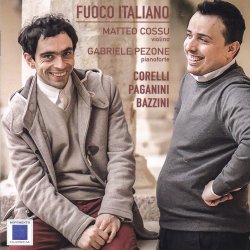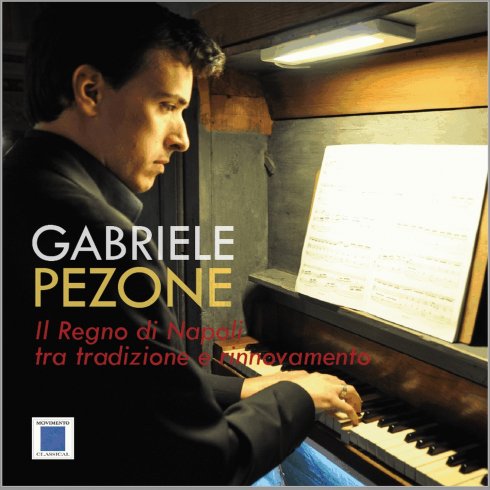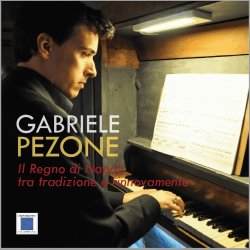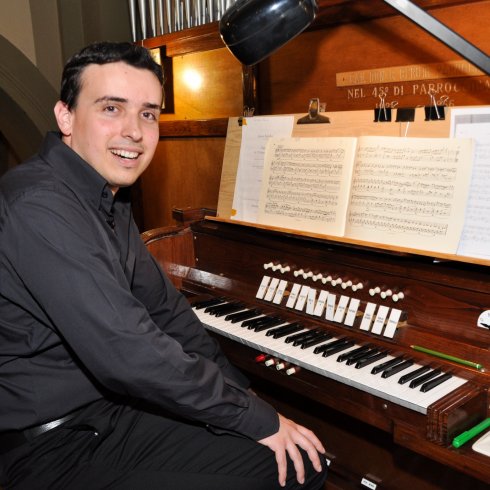

Il regno di Napoli tra tradizione e rinnovamento
Gabriele Pezone
The kingdom of Naples between tradition and renewal
The music chosen by Maestro Pezone turn to a repertoire little practiced and which, however, brings us back the image of an interesting story concerning the south of Italy and, in particular, Naples as a dynamic place, hotbed of artists and a reference point for musicians from all over Europe; the most interesting aspect is that, as evidence of this dynamism, have been chosen almost all artists born or operating in places far from Naples but who necessarily had to pass through this city. Another singular aspect concerns the choice of the instrument that aims at the rediscovery and revaluation of the organ for its sonic and expressive potential as well as related to cultural heritage: the churches of Italy are scattered with organs that witness a liturgical-musical practice rooted in the past but, now, almost completely extinct. Between the eighteenth and nineteenth centuries, southern Italy was repeatedly devastated by battles, sieges and changes of dynasty, traumatic and extremely significant events so as to leave their mark even in the artistic products: one of the works presented is linked to the commemoration of the fallen during the capture of Gaeta by Eugene of Savoy, leader of the Habsburg army; the city of Gaeta, it should be remembered, had a great strategic importance for the kingdom of Naples because it was a sort of gate that opened the way to all southern Italy, for this reason it was militarized and fortified in order to survive to long sieges. In 1707, the Habsburg troops managed to triumphantly enter the city and from there they descended to the conquest of the Kingdom of Naples taken away from the Spanish viceroys and handed over to the Habsburgs of Vienna who remained there until 1734.
The Belgian composer Jacques-Alexandre de Saint Luc (1663-after 1700) was at the service of Eugene of Savoy as court lutenist and chapel master and, on the occasion of the important victory, he dedicated to the prince a Suite in D major of eight small tracks entitled Pour la prise de Gaeta; the Suite is a collection of stylized dances of which the main ones were four: Allemanda, Corrente, Sarabanda and Giga. In addition to these canonical forms, de Saint Luc introduces other less common dances such as the Passpied of English origin and with a cadenced movement; the Rigaudon pour fa trompette, for the organ register of the trumpet which underlines the celebratory occasion for which the Suite was composed; the Caprice en Passacaiffe, very bizarre track that presents some anomalies so much that Maestro Pezone decided to perform it until the change of time in 9/8 since, in the last section, the song presents elements that contrast with the character and style of the rest of the Suite.
The second character we encounter in this organ excursus is Domenico Zipoli (1688-1726 ca) probably born in the Grand Duchy of Tuscany, in Prato; given the few and often incomplete sources, it is difficult to outline precisely the figure of this composer but we know that, certainly, he was sent to Naples by the Grand Duke Cosimo lii to perfect his studies with Alessandro Scarlatti, from whom he soon departed due to deep differences. Before embarking as a Jesuit missionary for Latin America, Zipoli occupied the role of organist of the church of Jesus in Rome composing music that is very suitable to be performed on the so called "Italian organs", called this way for their particular structure with a single manual in use, especially in southern Italy, until the end of the eighteenth century. One of the few works by Zipoli that have survived to this day are the “Sonate d’intavolatura per organo e cimbalo”, published in Rome in January 1716. From the corpus of the sonatas, which reveal strong influences of Girolamo Frescobaldi, it was decided to perform a group of four verses concluded by a canzona and an offertory; the verses are short organ interludes performed in place of a psalm or other liturgical chant with a heterogeneous character that allows to exalt the organ in its various registers and sounds: the first one has a toccatistic character with brilliant passages of scales while in the rest of the verses the imitative counterpoint or the fugue prevails; the series is closed by the canzona which, historically, derives from the free instrumental paraphrase of the French vocal chanson. A characteristic feature of these “Sonate d’intavolatura per organo e cimbalo”, so much to make them unique in the history of music, is the lack of tempo indication due to the "promiscuous" use that was made of this music which could be performed on various liturgical occasions simply changing the course of the tracks.
We now come to one of the spearheads of the entire Neapolitan school, Domenico Scarlatti (1685-1757) whose presence in the history of Western music is mainly linked to the huge corpus of sonatas for harpsichord: there are more than five hundred compositions in all of which, a small part, preserved in an English printed edition and the rest in fifteen manuscripts written by Father Antonio Soler.
This collection of sonatas is a kaleidoscope of short pieces/tracks but with a virtuoso and heterogeneous character composed for a small circle of listeners, the Queen of Spain Maria Barbara and a few close aristocrats. From this immense corpus, the sonata k287 in D major has been chosen because it is specially composed for organ: the structure of this sonata, unlike the canonical one in three musical tempos and in sonata form to which Viennese classicism has accustomed us, is in a single fugue style movement. Another great southern Italy composer to whom homage is paid is Giovanni Paisiello (17 40-1816), a brilliant opera player who deserves to be reproposed and studied with greater attention; after having spent most of his life as a wanderer between Italy and Russia, Paisiello returned to Naples in 1784 in the service of King Ferdinand IV of Bourbon who appointed him Master of the Palatine Chapel where the composer was in charge of liturgical services. In 1787, Ferdinand IV, who had initiated a series of reforms aimed at strengthening the state as well as at spreading the royalist and absolutist ideology, commissioned Paisiello to compose a hymn in his honor; The Hymn to the King, which became the anthem of the Kingdom of the two Sicilies from 1816, the year of its foundation, until its fall. Of this hymn it is executed the organ adaption by Graziano Fronzuto. Given its character as an identity symbol of the southern italy people, in the aftermath of the founding of the Kingdom of Italy, traces of this anthem were lost because it was necessary to disperse everything that could threaten the very recent and fragile unity of the country. As for Thomas Attwood (1765-1838), his piece/track is linked to the figure of the English admiral Horatio Nelson who won the Napoleonic fleet in the Battle of Trafalgar (1805) in which Southern Italy also participated.
Nelson achieved perhaps the greatest victory in the history of the British Navy and, wounded to death during the fighting, gave orders to draw/make the coffin for his own burial from the wood of the mainmast of the French flagship as if to remind himself that, despite his greatness and military glory, he remains mortal like all men. "Truly a fine example of greatness and morality - according to Maestro Pezone - compared to the common attitude we are used to immersed as we are in a reality crossed by a profund economic crisis but, even more so, by a tremendous crisis of values".
We have reached the late nineteenth century with the popular hymn to Pius IX composed by Gioacchino Rossini (1792-1868) in 1846 at the behest of the Bolognese patriots, on the occasion of the accession to the papal throne of Giovanni Maria Mastai Ferretti. Due to time constraints, Rossini did nothing but adapt the “coro dei bardi” that closes the first act of the opera “La donna del Lago” to which will be added the words of Gaetano Golfieri, a priest with a classicist education; this hymn was inserted in honor of one of the most important events for the Catholicism: the promulgation of the dogma of the Immaculate Conception with the “lneffabilis Deus” papal edict of 1854 promulgated by Pius IX who received the illumination in the “Santuario della Santissima Annunziata” during his exile in Gaeta. The organ excursus ends with Gaetano Donizetti (1797-1848) an opera composer and great artistic director of the San Carlo theather in Naples, of which two of the very few titles related to his organ production are proposed: The “Grande Offertorio in D major” and “the Grande Offertorio per organo o pianoforte in C minor/major” both reductions of symphonies of the operas “Anna Bolena” and “La Parisina”.
The “Offertorio” was the moment of the mass in which the organist could show off his skills and that’s why, the composer from Bergamo composed two pieces/tracks of great virtuoso/virtuosic value that make the most of the possibilities of the instrument so as to give the idea to listen to an entire orchestra.



Gabriele Pezone
He studied piano with Antonio Luciani, graduating at the Conservatory of Latina with Salvatore Coggi and choral music and choral conducting with Mauro Bacherini . He studied organ and organ composition with Luigi Sacco and composition with Alberto Meoli , organ improvisation with Stefano Rattni and he perfected in organ with Mariella Mochi and Olivier Latry and in piano with Alessandra Ammara and Roberto Prosseda. He studied liturgical animation with Marco Frisina and conducting with Nicola Samale and Deian Pavlov . He has conducted orchestras all around the world, including : Vidin State Philharmonic Orchestra (Bulgaria), Orquesta Sinfonica del Estado del Mexico, l'Orquesta Sinfonica de Yucatan, la Camerata de Coahuila, l'Orquesta de la Universidad Autonoma de Nuevo Leon, the Orquesta Sinfonica de la Universidad Autonoma del' Estado de Hidalgo and the Orquesta Sinfonica de Michoacan (Mexico), Lomza Chamber Phllharmon, Kallsz Orchestra and Philharmonic Orchestra (Poland), Orkestra Akademik Baskent (Turkey), the Southern Arizona Symphony Orchestra and the Las Colinas Symphony Orchestra (USA), the Cantell1d1milano Orchestra and the Sanremo Symphony Orchestra (Italy), the Orquesta Sinfonica de Loja (Ecuador), the Orchestra of the Opera of Ukraine, the Cairo Symphony Orchestra (Egypt), the West Bohemian Symphony Orchestra and the North Czech Philharmonic Orchestra (Czech Republic) in the prestigious Smetana Hall in Prague and the Bitola Chamber Orchestra (Macedonia). He has directed numerous operas, including "La Traviata” at the theatre "A. Manzoni" of Cassino, "Madama Butterfly" at the theater "G. D'Annunzio" of Latina and "Tosca " at the Borgiane Evenings of Nepi. He has also performed as a pianist or organist in Croatia, France, Sweden, Australia, Denmark, Spain, Hong Kong and New Zealand.
He is the founder of the Chamber Orchestra "Città Di Fondi". In 2006 he was the winner of the International Award "Giuseppe Sciacca", delivered to the Chamber of Deputies. He is the artistic director of the Fondi Music Festival , of the Festival Organistico Pontino and of the "lnFondi Musica" musical specialization courses. His performances were broadcast by TVP (Poland), Radio Mana, SAT2000, Rai Uno and Rai Tre. He recorded for Amadeus. As an accordionist he won the "Best Music Award" at the 8th Nicosia lnternational Folk Dance Festival (Cyprus)
